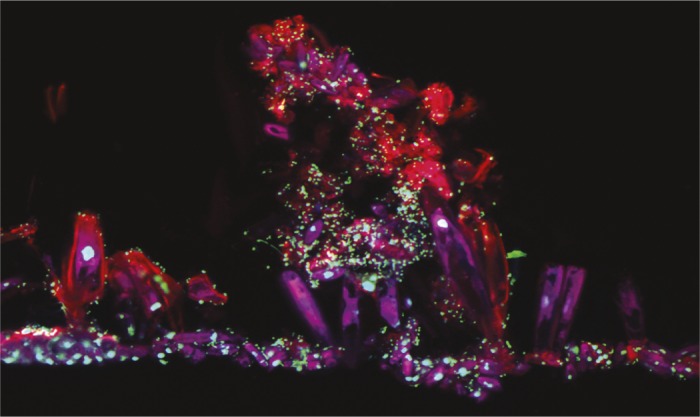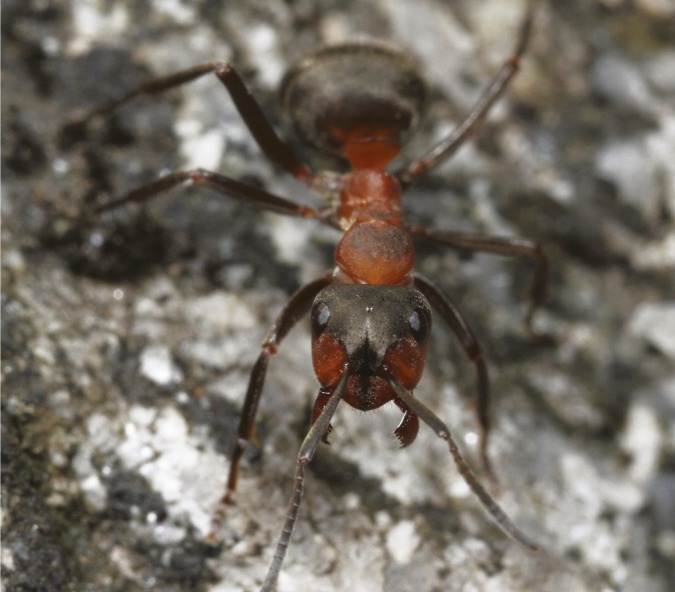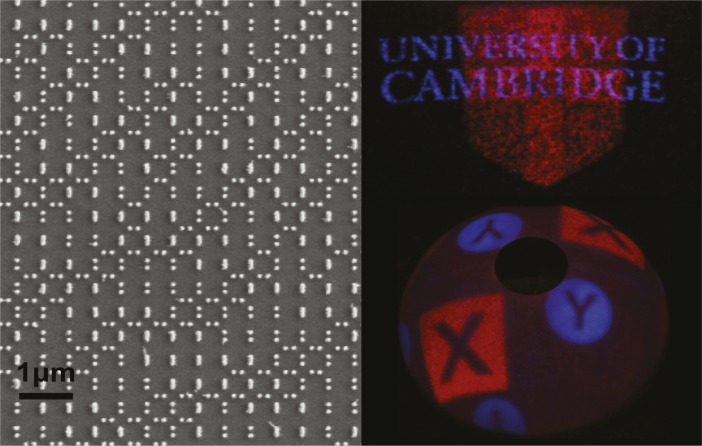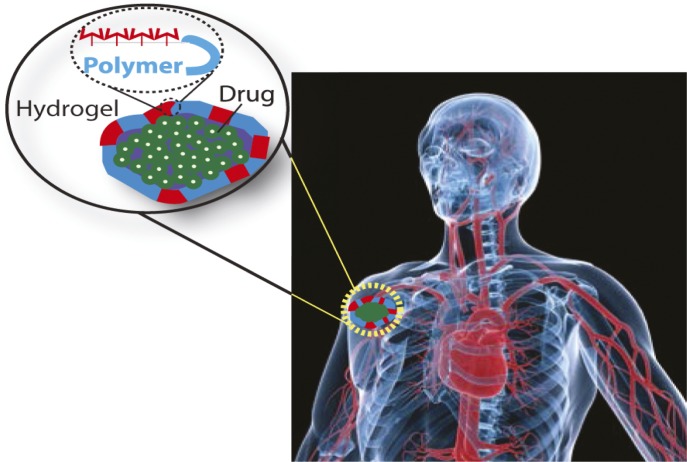Plasmonic nanoparticle arrays produce multicolor holograms
Nanoparticles with different geometries produce independent colors in holographic reconstructions.
When light strikes metallic nanoparticles such as gold or silver, specific wavelengths can drive free electrons in the metal to oscillate in concert, an effect known as surface plasmon resonance. This effect can be exploited for a wide range of applications, but the technologies needed to accurately manipulate nanoscale structures have only emerged recently. Yunuen Montelongo et al. (pp. 12679–12683) describe how optical scattering by plasmonic nanoparticles can produce multicolor holograms, based on an approach similar to the diffraction produced by atomic scattering in X-ray crystallography. Using the diffraction produced by scattering from arrays of nanoparticles, the authors show that all the scattering characteristics of the nanoparticles can be transferred to a reconstructed field for direct white light illumination. Furthermore, multiple arrays of plasmonic nanoparticles can be multiplexed to carry independent information such as polarization and wavelength, and thus achieve multiple colors. Such holograms, fabricated from a single thin film of silver, demonstrate an approach to advance diffractive optics, information storage, and 3D displays, according to the authors. — T.J.
Direct imaging of an extrasolar planet

Combined 30-m GPI image of Beta Pictoris depicts the planet Beta Pictoris b (bright spot) orbiting its star (Center), subtracted from the image.
The Gemini Planet Imager (GPI), installed on the Gemini South telescope in Chile, is dedicated to obtaining direct images of extrasolar planets. GPI actively corrects for interference from Earth’s atmosphere and for the bright halo appearing in images of stars to produce clear pictures of extrasolar planets. Shortly after GPI installation in November 2013, Bruce Macintosh et al. (pp. 12661–12666) imaged the star Beta Pictoris, which is orbited by a massive previously discovered Jupiter-like planet. Previously, imaging the planet required tens of minutes of observation and extensive image processing; GPI detected the planet in single 60-second raw exposures. GPI observations, in connection with previous measurements, show that the planet has an orbital period of 20.5 years and is moving, as seen from the Earth, back toward the parent star. The planet orbits at around 9 astronomical units from its star—slightly closer than Saturn from the Sun, with an orbit almost precisely aligned with the line of sight to the Earth. The results suggest that GPI’s demonstrated sensitivity might help discover more exoplanets in an upcoming survey of 600 young nearby stars, according to the authors. — P.G.
Noninvasive resupply of drug depots
Drug depot implanted in a human chest.
Drug delivery depots are nontoxic materials that are implanted or injected into the body to release a continuous supply of therapeutic drugs. However, once a depot is depleted of drugs, there is currently no way to refill it. Yevgeny Brudno et al. (pp. 12722–12727) experimented with injectable polymers designed to carry a resupply of drugs through the bloodstream to replenish depots and ensure continued therapeutic drug delivery. The authors engineered alginate hydrogel strands that bind a drug payload and an oligonucleotide sequence. After injection into mice, the oligonucleotide sequence of the drug-carrying strands selectively bound to a complementary oligonucleotide sequence contained in the alginate polymer of drug depots that had been implanted within tumors. Fluorescent imaging revealed that the drug accumulated in the tumors, but not elsewhere in the body, and that tumors had shrunk. According to the authors, the results suggest that targeted, drug-carrying polymers can travel through the bloodstream to noninvasively refill drug depots and may be used to treat cancer, heal wounds, and replenish drug-treated stents and grafts. — J.P.J.
Microbial community fragmentation in fluvial networks

Confocal laser scanning micrograph of a benthic biofilm. Diatoms and bacteria glow green in a red polymeric matrix.
In stream ecosystems, where hundreds of microbial species live in close proximity, microbial biofilms represent important but largely hidden players. Despite controlling fundamental processes that orchestrate biogeochemical fluxes, the ecology and spatial dynamics of these complex communities remain poorly understood. Stefanie Widder et al. (pp. 12799–12804) applied co-occurrence networks to biofilms in fluvial networks to determine whether the structure of the landscape leaves an imprint on the ecological networks of the organisms that inhabit it. Based on DNA analysis of biofilm communities in 114 streams, the authors found that hydrology and the dynamics of the metacommunity—all interconnected communities in a given landscape—affect the degree to which the co-occurrence network is fragmented throughout the fluvial network. Furthermore, the authors report that removing certain populations disproportionately contributes to network fragmentation, suggesting a critical role for biofilms in stream ecosystems. The findings help clarify how microbial communities respond amid human pressures on hydrological regimes and biodiversity dynamics in fluvial networks, according to the authors. — T.J.
Natural selection in real time

Hybridization revealed by wood ants. Image courtesy of Nick Bos (University of Helsinki, Helsinki).
Recent revelations that genomic hybridization may be central to both speciation and evolutionary adaptation have challenged widely held notions that the process in animals is rare and prone to reproductive dead ends. Jonna Kulmuni and Pekka Pamilo (pp. 12805–12810) previously reported that hybridization is more common in female than male Formica wood ants, a phenomenon that produces extensive and stable genomic differences between the sexes. The authors’ current work reveals that genomic exchange between Formica wood ant species is concurrently selected for and against, promoting strong natural selection. The authors compared ant genotypes from different developmental stages to explore the maintenance of sex-specific introgression—the transfer of genetic information through hybridization and repeated backcrossing—and genetic differences between the sexes. Introgression is favored in diploid females but selected against in haploid males, the authors report, suggesting that the genomic regions transferred via introgression harbor both fitness-enhancing and fitness-reducing elements. These findings suggest that strong selection, rather than sex-dependent transmission, maintains the genetic differences between sexes. According to the authors, the findings provide an opportunity to observe natural selection in real time in nature, and suggest a role for adaptive genetic variation in current models of genomic divergence. — A.G.
Vaccine efficacy against variant polio strains
As the global effort to eradicate poliomyelitis enters its final phase, variants of the virus may arise in populations with low vaccine-derived immunity. Jan Felix Drexler et al. (pp. 12889–12894) studied a 2010 outbreak of polio in the Republic of Congo with an unusually high fatality rate of 47%. Researchers had previously attributed the outbreak’s severity to low immunization coverage, but the efficacy of vaccine-mediated immunity in the outbreak had not been studied. The authors found that the strain, wild poliovirus 1, contained a previously unknown combination of amino acid exchanges in a critical antigenic site. To investigate the efficacy of common polio vaccines against the outbreak virus, the authors tested several polio strains, including the outbreak strain, in sera from 24 fatal cases and 63 other vaccinated individuals, including 34 routinely vaccinated German medical students and 17 German outpatients. Vaccine-mediated neutralizing antibody titers in these sera were significantly lower against the outbreak virus than against other strains, and up to 29% of sera from students or outpatients were essentially unprotected from the outbreak virus. The results suggest that sustained vaccination coverage and clinical and environmental surveillance might be necessary in the final stages of polio eradication, according to the authors. — P.G.




